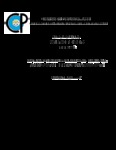| dc.description.abstract | Los objetivos de la presente investigación fueron:1) Conocer si plantas de chile,
resistentes a Phytophthora capsici, del genotipo CM-334 inoculadas con Nacobbus
aberrans responden hipersensitivamente a las inoculaciones foliares con
Pseudomonas syringae pv. tagetis y P. capsici; y 2) Comparar el contenido de
capsidiol en plantas infectadas y no infectadas con N. aberrans e inoculadas con la
bacteria o el oomiceto. En un primer experimento, se evaluaron ocho tratamientos: 1)
CM-334 con N. aberrans (2000 J2/planta) y P. syringae (108 ufc mL-1 ) (R+N+Ps), 2)
CM-334 sólo con P. syringae (R+Ps), 3) CM-334 sólo infiltrado con agua destilada
estéril (R s/N s/Ps), 4) CM-334 con N. aberrans y P. capsici asperjado (105
zoosporas mL-1) (R+N+Oa), 5) CM-334 sólo con P. capsici asperjado (R+Oa), 6)
CM334 sin nematodo ni oomiceto (R s/N s/O), 7) Susceptible sólo con P. capsici
asperjado (S+Oa), y 8) Susceptible sólo con P. syringae (S+Ps). En seis plantas de
los tratamientos R+N+Ps, R+Ps, R s/N s/Ps, y S+Ps se realizaron observaciones
durante 7 días. Para determinar el contenido de capsidiol, de cada tratamiento con
CM-334 inoculado con el oomiceto o la bacteria se tomó el follaje de 10 plantas a los
3 y 6 días post-inoculación con el patógeno. En otro ensayo se evaluaron los
tratamientos:1) CM-334 con N. aberrans y P. capsici infiltrado (R+N+Oi), 2) CM-334
sólo con P. capsici infiltrado (R+Oi), 3) CM-334 sólo infiltrado con agua destilada
estéril (R s/N s/O), y 4) Susceptible infiltrado con P. capsici y sin nematodo (S+Oi),
se realizaron observaciones durante 30 días para registrar la aparición de síntomas
de tizón foliar o de la reacción de hipersensibilidad (RH). La infección de CM-334 por
N. aberrans no inhibió la RH en la parte aérea de la planta, pero si causó un retraso
importante en su expresión, ya que en ausencia del nematodo el inicio de la
respuesta se observó a las 5 h y la típica RH se expresó a las 7 h posteriores a la
inoculación con la bacteria, mientras que en presencia del nematodo a este último
tiempo, apenas se apreció una clorosis incipiente. En el segundo ensayo, a pesar de
que el nematodo retrasó la expresión de la defensa en la planta, tal retraso no fue
suficiente para permitir el establecimiento exitoso de P. capsici en el follaje. A los 3
días post-inoculación con el oomiceto o la bacteria en hojas de CM-334, previamente
inoculadas con N. aberrans, la acumulación de capsidiol fue reducida (23 y 63 %,
respectivamente) en comparación con aquellas sin nematodo____________The objectives of this research were: 1) To know if chilli plants of the CM-334
genotype, resistant to Phytophthora capsici and previously inoculated with Nacobbus
aberrans, respond hypersensitively to foliar inoculations with Pseudomonas syringae
pv. tagetis and P. capsici; and 2) To compare the contents of capsidiol in plants
infected and noninfected with N. aberrans and inoculated with the bacteria or the
oomycete. In a first experiment, eight treatments were evaluated: 1) CM-334 with N.
aberrans (2000 J2/plant) and P. syringae (108 cfu mL-1) (R+N+Ps), 2) CM-334 only
with P. syringae (R + Ps), 3) CM-334 only infiltrated with distilled water (R s/N s/Ps),
4) CM-334 with N. aberrans and P. capsici sprayed (105 zoospores mL-1) (R+N+Oa),
5) CM-334 only with P. capsici sprayed (R+Oa), 6) CM-334 without nematode or
oomycete (R s/N s/O), 7) Susceptible only with P. capsici sprayed (S+Oa), and 8)
Susceptible only with P. syringae (S+Ps). Observations during 7 days were carry out
in six plants of the treatments R+N+Ps, R+Ps, R s/N s/Ps, and S+Ps. To determine
the capsidiol content, from each treatment of CM-334 inoculated with the oomycete or
the bacteria, the foliage of 10 plants was taken at 3 and 6 days after pathogen
inoculation. In other assay the treatments: 1) CM-334 with N. aberrans and P. capsici
infiltrated (R+N+Oi), 2) CM-334 only with P. capsici infiltrated (R+Oi), 3) CM-334 only
infiltrated with distilled sterile water (R s/N s/O), and 4) Susceptible infiltrated with P.
capsici and without nematode (S+Oi), were established. Observations were carried
out during 30 days to register the appearance of leaf blight symptoms or the
hypersensitive reaction (HR). The infection of CM-334 by N. aberrans did not inhibit
the HR in the plant foliage, but it caused an important delay in its expression, since in
the absence of the nematode the onset of the response was observe at 5 h and the
typical HR was expressed at 7 h after the bacterial inoculation, while in the presence
of nematode by this time there was an incipient chlorosis. In the second trial, even
though the nematode delayed the expression of the plant defense, such a delay was
not sufficient to enable the successful establishment of P. capsici in the foliage. At 3
days after leaf inoculation with the oomycete or bacteria in plants previously
inoculated with N. aberrans, the accumulation of capsidiol was reduced (by 23 and
63%, respectively) as compared with those without nematode. | es |

